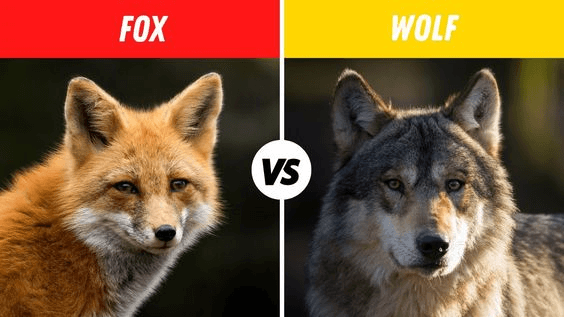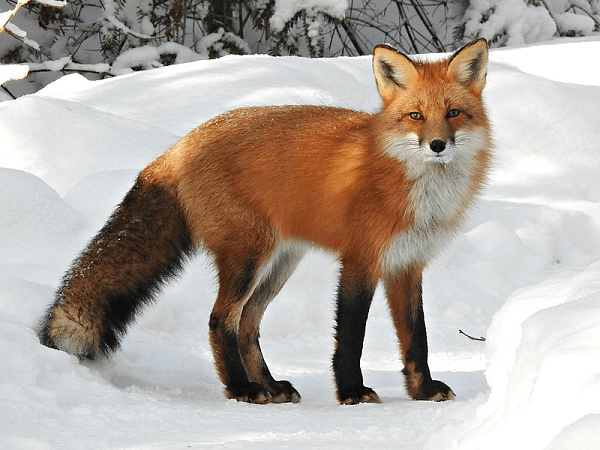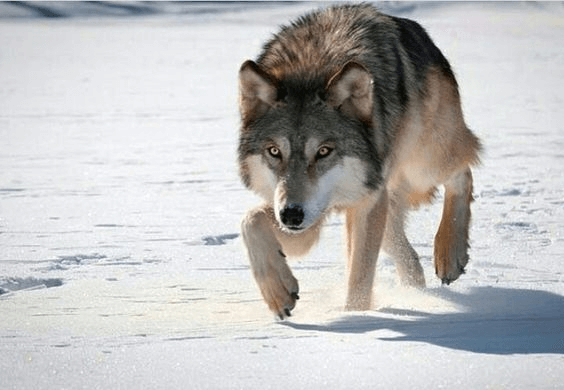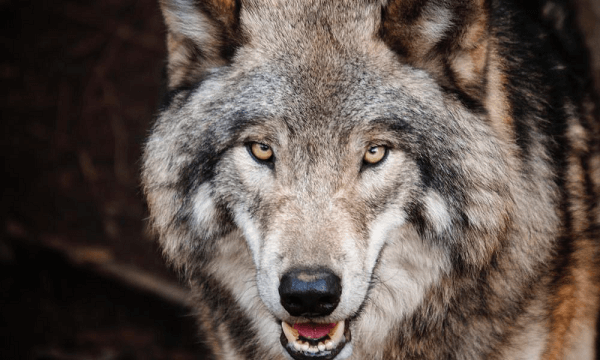Difference between Fox and WolfFoxes and wolves are canids. They belonged to the Canidae genetic group of omnivorous and predatory animals. Coyotes, jackals, and your average domestic canine are also family members. They both exist in communal communities as social creatures. They are very different in look, demeanor, nutrition, and vocalization despite having very identical dispositions. 
The fox and the wolf are thought to be close relatives because they are both members of the Canidae family. Yet they vary greatly from one another not only in terms of height but also with respect to their primary activities, feeding, and poaching habits. Typically scarlet in color, foxes have pointy noses, long eyebrows, and thick tails. Wolves typically have dark fur, a wide muzzle, and tiny ears. Despite being omnivores like humans, wolves prefer to pursue bigger animals. Both animals are wise, obstinate, and excellent parents or guardians. Foxes prefer to live alone or in pairs rather than in groups. Humans are much more afraid of wolves than foxes because they tend to be more predatory. Foxes are more tolerant of people. Wolves usually reside in groups of six to ten. They target big creatures for food. Wolves howl instead of the fox. Foxes are found nearly anywhere, whereas wolves are typically found in the northern parts of the country. Wolves are bigger than other animals in comparison. An adult wolf can grow to be approximately three feet tall and weigh roughly 150 pounds. A fox, on the other hand, can grow to a height of about 1 foot and weigh around 30 pounds. A wolf's young are referred to as puppies, while a fox's young are referred to as kits. A puppy can be found in red, grey, silver, or white, whereas a youngster will typically be available in grey, white, brown, and black. Both the fox and the wolf are threatened species. FoxesFoxes are carnivorous, tiny to medium-sized animals that fall under the family Canidae. They are diminutive to medium-sized canines with shaggy tails, long hair, pointy ears, and a tiny muzzle. Red foxes are the most commonly encountered fox type, and they can be found everywhere except Antarctica. 
Foxes in the wild have a ten-year lifespan. They only have a two- to three-year lifespan, though, due to illnesses, shootings, and other mishaps. They typically consume animals such as voles, rabbits, rats, and hedgehogs, as well as edibles such as grapes. Foxes are regarded as intelligent and skilled predators. They possess the same traits as other predatory animals that seek to live. WolvesThe biggest natural species of the Canidae family is the grey wolf, also known as the wolf. In the past, they were common throughout Eurasia, North America, and North Africa. These wolves are sociable carnivores that move and reside in packs. The dominant mating and feeding privileges are held by a married couple, followed by the legitimate children and, occasionally, the chosen followers. They are regarded as top hunters as well. Tigers and people are the two main dangers to their existence. 
Due to their ferocious nature and propensity for predatory behavior, wolves are big dogs that have long been dreaded by people. Bloodcurdling Howls from wolves are frightening. They have no trouble capturing large prey due to their size and the fact that they forage in groups of 6 to 10 animals. Wolf populations have rapidly decreased as a consequence of years of persecution due to dread and killing. Red and grey wolves are both threatened animals. European, Alaskan, Canadian, and Asian regions are home to grey wolves. The Southeast of the United States is home to red wolves. Key Differences between Fox and WolfDespite their variations, what distinguishes them from one another is their ability to endure in the constantly expanding human race. They obviously vary in height, but they are also polar opposites when it comes to humans. Since they consume food from humans as well as some trash, foxes can typically flourish in human interaction. Even though they are more frightened of people, they rarely get hurt unless there are vehicle crashes. Wolves, on the other hand, are either pursued or dreaded; as a result, they are now forced back into the hills in search of secure territory because they require more space for their group. These are animals that strive to endure in defiance of alterations to their native habitats. We must admire them for their resilience and perseverance in the face of hardship because the population is driving them farther from their former range.
Fox vs. WolfWe will examine the above layout in more detail and dig into the distinctions between a wolf and a fox in the following section. 1.Family:The canine genus includes both the wolf or grey wolf (Canis lupus) and the fox or red fox (Vulpes). Although wolves can be encountered in Europe and Asia, both of these creatures are prevalent in North America. Compared to wolves, foxes are more broadly distributed. You can find these cunning little creatures in North America, Europe, Asia, and North Africa. Compared to the 38 varieties of wolves, there are about 47 recognized variants of a fox. Given this information, it should come as no surprise that foxes are more widespread than wolves around the globe. 2. Size:A wolf is significantly larger compared to a fox; a mature male wolf can grow to be about 3 feet tall, whereas a mature male fox is roughly the size of a medium-sized canine or large cat(Around 1.3 feet). Foxes solely weigh 30 pounds, whereas wolves can weigh up to 150-180 pounds; this is a significant variation. To put it another way, a wolf is roughly six times larger than a fox. Because of their big, powerful frame, wolves usually weigh more. In comparison to wolves, foxes are much smaller. They can grow to a length of between 90 and 105 centimeters, or 36 and 42 inches. The tail is included in the measurement, so foxes would be even tinier if you did not! 3. Height:How to determine a wolf's height has generated a lot of discussion over the years. changes based on the wolf type, with the largest being the Mackenzie Valley wolf, which may develop to be up to 81-102 cm (32-40 inches) in height at the shoulder area as well as between 1.5 and 2.1 meters (5-7 feet) in length (head and tail included). The Ethiopian wolf, which measures only 50 centimeters (20 inches) at the hip, is the tiniest member of the wolf family. 4. Tone and Coloration:The scarlet fox and grey wolf both have colorful fur due to the color of their hair. The typical fur pelt of a fox is orange or red, whereas the wolf is mainly speckled grey. Even so, each genus varies from the others. Several wolves are entirely white or black, while others have white, tawny, red, or black patterns. Only the natural environment contains these. The scarlet wolf is a variety that originated in North America. There are fox varieties that are silver, grey, or white with red, black, or brown patterns that can be found in the wild. Typically, foxes have black patterns on their face, whiskers, and feet. 5. Health and Behavior:In terms of their social structure and the prey they pursue, wolves and foxes behave differently. Due to their reclusive nature, mature foxes are rarely seen in groups and only appear in them when educating their young. These creatures hunt alone due to the small size of their food. They consume foliage, insects, larvae, and tiny animals in addition to rodents like mice, birds, and bunnies. Wolves, on the other hand, are incredibly social creatures, and they prey on and reside in groups. They appreciate living in communities and hunting big game like deer, bison, moose, elk, livestock, and reindeer together as a squad. Foxes are more likely to be interested in people, whereas wolves will stay away from people and prevent any contact with them. 6. Vocalization:Foxes converse with one another by whimpering, snarling, and howling. During the breeding period, they also produce a high-pitched noise that (quite frighteningly) resembles a lady shrieking. While female foxes shriek to entice a possible male partner, male foxes bellow to drive away other male competitors. Wolves can communicate across great distances by howling loudly. 7. Habitat:Except for Antarctica, most regions of the world are home to foxes. They occupy farmland, metropolitan places, maritime regions, mountains, high woods, and rural areas. Although they prefer to be alone, this species does periodically congregate in teams of two or three creatures. They typically inhabit forests, but they can also be found on slopes, in meadows, and in deserts. Wolves, on the other hand, are hemispheric-exclusive and favor meadows, woodlands, dunes, and Polar Regions. These creatures reside in large packs of between six and ten wolves and are amicable. They can survive in the Arctic, woods, forest, meadows, and dunes, depending on their habitat. 8. Offspring:A female fox is capable of giving birth to four or five kits, which are the young. They have scarlet, white, or silvery hair at birth. A brood of fourteen to seventeen puppies can be born to a female wolf during times of plentiful sustenance. Female wolves typically give birth to five or six pups per season. Pups, the name given to the young, can be grey, black, white, or brown. 9. Bite Force:The canine species with the strongest bite force or weight per square inch are wolves. Their bite force, or PSI, is at a whopping 406. Considering that they pursue big, hoofed creatures, this is not surprising. If such a big animal is going to be pursued, the hunter must ensure they have the strength to support the chase. It is not surprising that a fox's PSI is much lower than a wolf's PSI given the physical disparity. Foxes' PSI reaches 92 PSI. It may not be as strong as a wolf, but considering its size, it is still quite remarkable. 10. Perceptions:It should not be surprising that wolves have keen perceptions. They can detect high-pitched noises, have a keen sense of scent, see in the dark, and comprehend quick movements. Foxes have keen ears and superb senses of scent. They can detect motion rapidly, but they may overlook still things. Even so, their perception is much superior to that of, let's say, human beings. As with any other species, both creatures have their weaknesses and strengths when compared to one another. Types of WolvesThe wolf has numerous species in various areas of the globe. For instance, the family Canines, to which wolves are related, contains 16 distinct species, including canines, jackals, coyotes, and others. The grey wolf has 37 species, 5 of these species have been specifically named here: 1. Grey WolfThe grey wolf, which is another name for forest wolves, is one of the more popular wolf species. The wolves are named after their grey coats, which have small brown patches and undersides. The southern grey wolves are smaller than the northern grey wolves, and the height of grey wolves fluctuates according to their region. One of the most prevalent species of grey wolves is the Russian variety. The usual places to locate grey wolves are Alaska, Northern Wisconsin, Northern Michigan, Northeast Oregon, Northern Idaho, and Western Montana. 2. Red WolfThe red wolf, which has black and dark hair with a reddish undertone on the back of its body, is a transitional species between grey wolves and coyotes. They are only found in a few isolated areas of Mexico, Canada, and the USA. They are endemic to the southern United States. The smallest and most vulnerable wolf breed is the red wolf. 3. Arctic WolfThe Arctic wolf is a white wolf species that lives in Canada's Queen Elizabeth Islands, in the world's most northern areas. It is conceivably the most well-known wolf species. The white hair of Arctic wolves sets them apart from other wolves, along with their light-colored fur. Despite the fact that it has been observed eating caribou and even Arctic foxes, Arctic wolves typically prey on muskoxen and Arctic hares. 4. Indian WolfThe Indian wolf happens to be one of the less widespread wolf varieties of the grey wolf, despite the fact that it can be found all over Southeast Asia and India. It lives in the wooded regions of India's peninsula. Indian wolves are small, have sparse hair, and have whitish extremities that contrast with their dark torso. 5. Black WolfThe black wolf is not a separate species but rather a melanocytic variation of the grey wolf. As a result, the wolves are all grey genetically, and their coats are all black. The grey wolf behaves and is found similarly to the black wolf in all other respects. Malamute and German shepherd hybrids resemble a black wolves. The most alluring characteristics of the black wolf are their penetrating eyes, along with their pointy ears and keen nostrils. Types of FoxesOver 37 different fox species exist. Only 12 of those species are regarded as the genuine model species of foxes in the genus Vulpes. They inhabit numerous areas and are found in numerous countries. The most typical variety of foxes is the red fox. We are discussing five of the original breeds of foxes below: 1. The Red FoxThe most common fox in North America, the American red fox, has a wide range and can be encountered in all 50 states. The question of whether the red fox is a resident of North America or a European import has been a point of contention among experts for a long time. However, these creatures are flourishing and will remain. The majority of the vibrant orange hair on red foxes is on their long, pointed snouts. The color of their undersides is deeper, typically grey or brown. On their soles and the ends of their ears, red foxes have black hair. They have a tail with a white tip and big, pointed ears. They are three feet long and about two feet tall. These foxes favor wooded or forested areas close to open spaces, such as grassland or a farming field. This environment is ideal for catching rabbits and rodents. Small animals make up the bulk of the red fox's diet. Yet, based on what is accessible, they consume food, nuts, animals, and vegetation for their nutrition. Red foxes are intelligent animals that are aware that people put food in their trash cans. Farmers have occasionally reported observing them consuming food intended for animals. 2. The Grey FoxAnother beautiful species of the Canidae family that lives in both North and Central America is the grey fox, whose scientific name is Cinereoargenteus, which means silvery or ashen. Due to settlement by humans and destruction, it used to have abundant numbers, but these numbers are now decreasing. Silvery grey hair, a tail with a black band, and a pointed nose are all characteristics of the grey fox. They weigh 15 pounds and have a maximum length of 44 inches. Given that it lacks dark paws, the grey fox can easily be distinguished from the red fox. It does, however, have a tail with a dark point. Numerous grey foxes also have a robber hood throughout their eyes made of black hair. Because they can scale branches and even spend the night there, these foxes are occasionally referred to as tree foxes. Grey foxes typically slumber during the day and prey at night, so they build their nests in any suitable empty trunk, tree, or hole that they're able to locate. Grey foxes have gotten nearer to human settlements over the past couple of centuries as the coyote population has grown in order to avoid being attacked by one. They spend the majority of their time foraging near wooded, forested, and other vegetation boundaries. 3. The Arctic FoxDue to its stunning white fur, the Arctic fox is also known as the white fox, snow fox, and polar fox. It is indigenous to Arctic areas, as its name would imply, and it thrives there. Arctic foxes live everywhere, from Alaska's shoreline regions to Canada's eastern boundary. It has dense hair that blends in well with snow and ice, and the exterior is white. In order to reduce heat loss, Arctic foxes are smaller than other foxes and range in length from 22 to 27 inches. They range in weight from 7 to 20 pounds. They've developed a number of modifications to help them endure the cold:
Due to its keen hearing, the Arctic fox is able to locate lemmings that are hiding beneath snow and ice. They have a keen sense of scent as well. Lemmings can be detected under 30 inches of snow, as well as a corpse 20 miles away. 4. The Kit FoxThe kit fox prefers mild temperatures and lives in Mexico's southwest and the dry southwest of the United States. Kit foxes, which are mostly nocturnal, spend the warmest part of the day resting and the coolest portion of the night foraging. They are among the few fox species that favor communal living over the solitary living. These creatures consume fish, rodents, invertebrates, birds, snakes, and other predators in addition to meat. They also consume human waste food, prickly fruit, and vegetables. Kit foxes create their own shelters or make use of prairie dogs or badger-leaved holes. Along their foraging area, they prefer to have multiple dens. Some even have eleven bunkers. The gestation period lasts 56 days, and the breeding season begins in the month of December. Kittens typically give birth in groups of four or five in February. The young are raised and fed by both parents. Kit foxes make a bonded couple and stay together all year. In the wild, kit foxes have a lifespan of 10 to 12 years. 5. Cape FoxAfrica's Saharan areas are home to the desert fox known as the Cape (Vulpes chama). They are among the few African foxes recognized to reside south of the tropics. Cape foxes tend to remain far from woodlands and build their shelters in semi-desert regions. They hunt at night, with the males hunting and the females hunting individually. They marry at the beginning of the year and give birth to their offspring in the summertime. They are faithful. They hoard and stockpile food, hiding it and keeping it for later as a lot of foxes do. They consume small animals like rabbits and mice. Additionally, they consume particular fruits and veggies, such as tubes and stems. Who Would Victory Be in a Battle? Fox or WolfWe have now arrived at the essential issue we asked about at the outset of this piece of content. In a battle between a wolf and a fox, which species will prevail? 
So it should come as no wonder that a wolf will easily prevail in a battle between a wolf and a fox. To be truthful, there wouldn't be much of a battle. You could now hypothesize that the fox might try to flee and conceal itself in a confined space that a wolf cannot squeeze into. This is certainly conceivable. Wolves, on the other hand, move even more quickly than foxes. The canines could easily catch up to the fox with little exertion. Once they do, the big animals' 400 psi bite force will obliterate the helpless little fox. When you stop to think about it, foxes are remarkable, cunning little creatures. They are incredibly agile and fascinating to observe or understand as well. To even stand a chance of living in a battle, the fox would need to flee promptly and conceal itself well. Since foxes are portrayed as intelligent creatures in popular culture, mythology, and tales, perhaps they could succeed.
Next TopicDifference Between
|
 For Videos Join Our Youtube Channel: Join Now
For Videos Join Our Youtube Channel: Join Now
Feedback
- Send your Feedback to [email protected]
Help Others, Please Share










